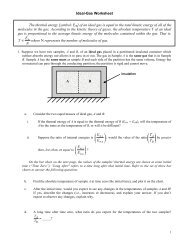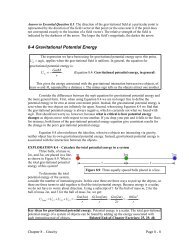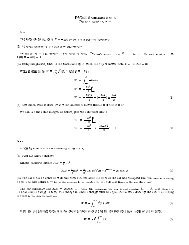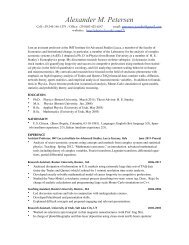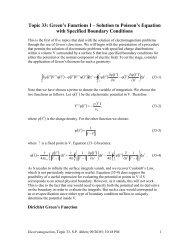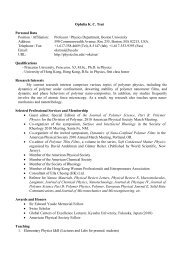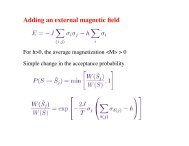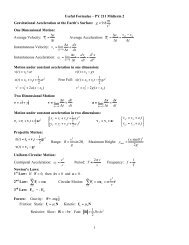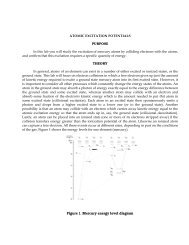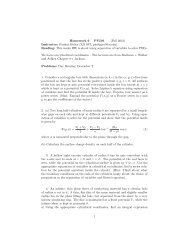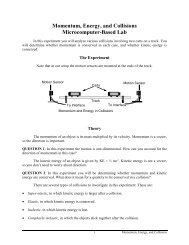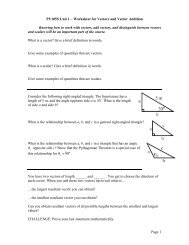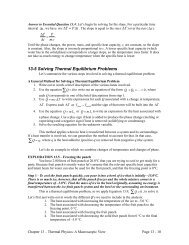arXiv:1303.7274v2 [physics.soc-ph] 27 Aug 2013 - Boston University ...
arXiv:1303.7274v2 [physics.soc-ph] 27 Aug 2013 - Boston University ...
arXiv:1303.7274v2 [physics.soc-ph] 27 Aug 2013 - Boston University ...
You also want an ePaper? Increase the reach of your titles
YUMPU automatically turns print PDFs into web optimized ePapers that Google loves.
61701601501401301201101009080706050403020101cumulative citationsCi(t) and ci,p(τ)rank-citationprofile, ci(r,t)Barabási, AL Laemmli, UK Wiles, A010 4 10 410 310 3 ζ = 4.5(2)10 3ζ = 3.4(1)10 2ζ = 2.30(4)10 210 210 110 110 110 010 010 010 10 0 10 110 0 10 110 1career age, t10 4 t=42t=32β = 0.92(8) β = 0.72(8)10 310 2t=21β = 1.04(4) 10 310 210 210 110 1 t=510 1 t=5t=510 010 010 010 0 10 1 10 2 10 0 10 1 10 2 10 0 10 1paper rank, rpaper rank, rpaper rank, r10 4⟶career age, t⟶10 3⟶career age, tFIG. 4: Quantitative patterns in the growth and size-distribution of the publication portfolio for scientists from 3 disciplines. (Top panels)Shown are the cumulative citation trajectories of each of their papers, with each author’s C i(t) ∼ t ζ iplotted as a dashed black curve. (Bottompanels) The evolution of each author’s rank-citation profile using snapshots taken at 5 year intervals. The darkest blue data points representthe most recent c i(r, t), and the subset of red data points indicate the logarithmically spaced data values used to fit the empirical data to ourbenchmark DGBD rank-citation distribution model [4] (solid black curve, see SI methods). The intersection of c i(r, t) with the line y = x(dashed black line) corresponds to the author’s h-index h i(t).III.DISCUSSIONSocial networks in science are characterized by heterogeneousstructure [25] that provides opportunities for intellectualand <strong>soc</strong>ial capital investment at the individual level [26],and influence scientists’ research strategies [21]. In this paperwe analyze the role of reputation on the micro-level processesunderlying the dynamics of a scientist’s research impact towardsthe broader goal to understand better career growth andthe increasingly difficult task of career evaluation [16].Patterns of career growth are important for establishing (i)benchmarks for career trajectory models, and (ii) a quantitativeevaluation framework that does not oversimplify or discountthe complex <strong>soc</strong>ial processes underlying scientific careers.Along these lines we observe for top scientists a robustpattern of super-linear growth for two cumulative reputationmeasures, N i (t) and C i (t), giving support to amplifying <strong>soc</strong>ialprocesses which sustain growth via coevolution of scientificcollaboration and output [6, <strong>27</strong>–29]. In a scientific systemincreasingly characterized by team endeavors, multiple levelsof hierarchy, and division of labor [30], it will be important todevelop both financial and prestige incentives that sustain lifetimeproductivity for scientists at every level of the scientificenterprise.As reputable teams start to dominate the scientific landscape,it will further become important to disentangle the reputationeffect as<strong>soc</strong>iated with elite labs in order to assess individualcontributions. To this end, quantitative measures arebecoming more prevalent in the evaluation of projects, labs,and various hiring and promotion scenarios affecting individualcareers in science. It is also increasingly important to understandthe relation between scientific inputs (money, labor,knowledge, reputation, etc.) and scientific outputs [6, 15, 17],the evolution of these dependencies across career stage, andthe role of career uncertainty [6]. Concerning careers, an institutionalsetting based on quantitative appraisal that neglectsthese features may paradoxically go against the goal of sustainingthe careers of talented and diligent young academics,especially considering the role that lab and mentor reputationplay in the hiring process. Indeed, our finding of a crossoverbehavior around c × shows how young scientists lacking reputationcan be negatively affected by <strong>soc</strong>ial stratification inscience, since there is a competitive advantage working with aprestigious mentor which is countered with the possibility thatit is not the ideal mentor-advisee match. In light of the value ofonline visibility, strategies of self-promotion may also emergeas scientists “game” the system, which may be hard to disentanglefrom other dimensions of science, such as the tendencyfor scientists to self-cite, possibly with the intentionof signaling reputation, when crossing disciplinary lines [31].Reputation will also become increasingly important in light ofthe preferential treatment based on citation measures given tosearch query results, e.g. Google Scholar, which may furtherstrengthen the reputation effect between paper and author.Our framework motivates future research to inspire institutionaland funding body evaluation schemes to appropriatelyaccount for the roles that reputation and <strong>soc</strong>ial context play inscience. For example, our results can be used in support ofthe double-blind review system perceived to have advantagesdue to its objectivity and fairness [32]. The reputation effect is


![arXiv:1303.7274v2 [physics.soc-ph] 27 Aug 2013 - Boston University ...](https://img.yumpu.com/51679664/6/500x640/arxiv13037274v2-physicssoc-ph-27-aug-2013-boston-university-.jpg)
